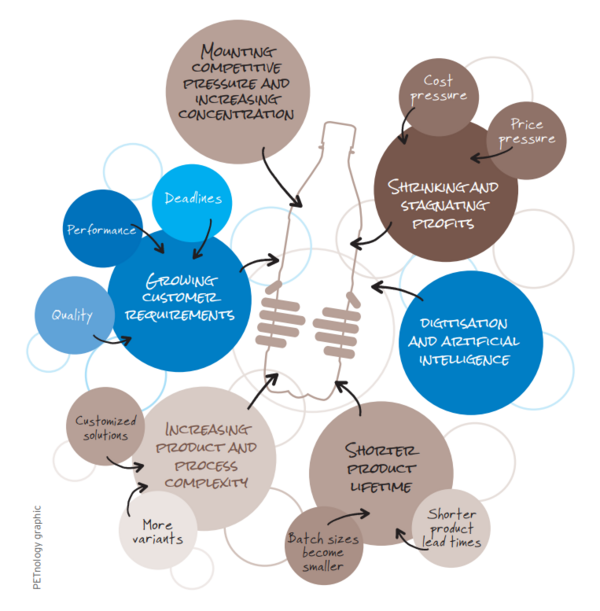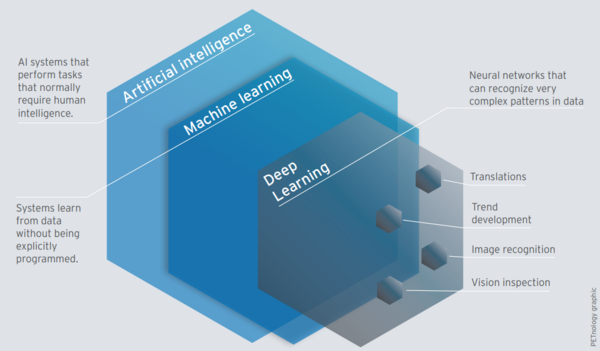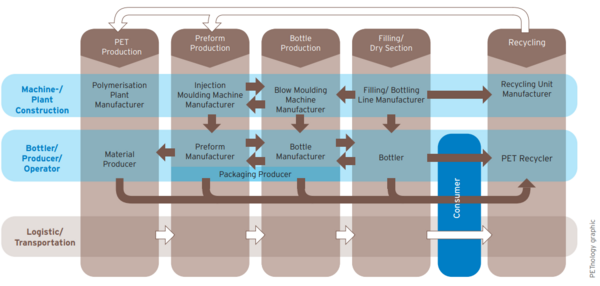

(Photo credit: Shutterstock)
DIGITISATION & ARTIFICIAL INTELLIGENCE
PET Packaging in the wake of Artificial Intelligence? - AI in PET packaging machinery - a process of imagination, creativty and implementation
Alongside recycling and circular economy, digitisation is the topic that every production company and every machine supplier has to deal with today. After Smart Homes, Smart Cities, Smart Mobility, a new era is beginning in production with Smart Factories.
We dedicated the very first issue of our comPETence magazine, ONE:15, published in March 2015, to the topic of digitisation and highlighted the impact of Industry 4.0 on the PET packaging industry. Today you are holding the 25th issue in your hands. Digitisation is again the main focus, and I am picking up on my article from back then. Not all examples will find their way into this article that show what has actually happened in our industry in this area over the past eight years, but we want to explain that things are getting rolling.
Challenges and pioneering spirit
For years, the challenges along the PET value chain, i.e. injection moulding, stretch blow moulding, filling, labelling, capping as well as the recycling processes, have been solved with engineering and technology - lighter, faster, less and more - i.e. less energy, less material and more rPET (fig. 1).

Speed is always an economic issue with PET stretch blow moulding or injection moulding technologies. But do all the technical and technological solutions - unquestionably all great feats of engineering - still trigger genuine enthusiasm? The industry is still setting records - as recently seen at Drinktec and K Show: Machines eject caps, bottles and preforms at ever higher speeds. Nevertheless, the feeling creeps in that the zenith in terms of speed has been reached: there are no longer any real quantum leaps, even if supposed limits are being exceeded.
_______________
Do our solutions still trigger genuine enthusiasm?
_______________
What does that do to the pioneering spirit? Does it still exist? Yes, I think so - but it thrives on a different terrain: we need to move towards AI - Artificial Intelligence - to rediscover the pioneering spirit in PET packaging.
Digitisation and Artificial Intelligence (AI)
We are now becoming increasingly aware of what has long since entered our lives. ChatGPT is an example of how quickly this process is progressing: People had hardly tried the magic text creation software released in October 2022 when the company Open AI presented the next generation of the so-called Generative Pre-trained Transformer on March 14th, 2023 in San Francisco. Compared to its predecessor GPT 3.5, GPT4 is said to be able to analyze and generate images, understand longer texts and be more creative. ChatGPT made uscurios: A complex technology becomes tangible in its application and sets the imagination in motion in the R&D departments of machine and system suppliers.
IT experts are somewhat puzzled by the current excitement and euphoria caused by ChatGPT. In their work and life environment, it is a matter of course, because they have long been drawing attention to the possibilities of AI with creative approaches and implementing various AI applications in established markets, e.g., with chatbots, an automated dialogue system that supports customer advisors and service employees in their work to answer customer questions about products 24/7.
The two letters AI have long since found their way also into the vocabulary of engineers. We are all familiar with inspection systems in medical or technical applications.
Overview
Digitisation is a profound key word that has changed our work, our processes, our lifes. As early as in 2006, a debate on digitisation was started in the USA under the heading of CPS (Cyber Physical Systems) – a debate that did not reach Germany until 2011, where it was known as Industry 4.0.
After CIM (Computer Integrated Manufacturing) and Lean Manufacturing, AI will revolutionize production and manufacturing processes as well as entire business processes and models.
All technological changes have transformed our social, economic and industrial lives - creating winners and losers. We have often seen that global market leaders reacted too late to change, that they only felt the pressure to change until it was too late, missing the signs, or not wanting to see them or take them seriously.
_______________
Imagination precedes, creativity follows, conviction implements
_______________
New companies or start-ups with innovative products and new business models tend to change the established “rules of the game” and are suddenly able to produce or offer products and services at much cheaper prices. In the past, quantum leaps were frequently made as the result of new materials and automation, changing, and even transforming, machines, processes and markets. Today, it is digitisation and artifical intelligence that are driving forward development (fig. 2).

When companies change, jobs change. You could say that jobs are shifting more than ever towards the requirement of better qualifications and, above all, boosted levels of creativity – at least at this stage in the digitisation era.
Digitisation, and now increasingly AI, affects societies and individuals, companies and workplaces, as well as production and individual manufacturing processes. AI will usher in a new era of PET packaging production and filling. On the way to smart factories, it will be interesting to follow the AI impact on the PET packaging industry (fig. 3).

What can the packaging and filling industry expect?
The increasing number of economic players in the PET packaging market coupled with growing customer expectations continues to intensify competition among PET packaging and PET machine manufacturers (fig. 4).

The pressure to meet the growing demands of a sustainability-oriented market and the technical customer requirements - such as higher quality demands and shorter delivery times - has set in motion an innovation spiral in the PET industry that may have meanwhile pushed productivity and energy consumption in closure, preform and bottle production to their limits.
What now? Machine manufacturers are still challenged to help their customers further reduce production costs with innovative developments.
If we look at the value chain in the production and filling of a PET bottle, it quickly becomes clear that market players are not only trying to come up with new innovations in order to compete, but are also expanding their activities in the neighbouring elements of the value chain (fig. 4). This process began several years ago and has led to the formation of larger companies and thus to concentration and market limitation
Each step towards mastering further parts of the value chain takes companies away from their core competencies, the goal being to expand these competences to exploit synergies, simplify business processes and improve profitability. However, this entails increasing complexity - both in terms of the market and the required reliability of the processes, machines and products. The ever-increasing recyclate content is further fuelling the complexity, and this does not only apply to PET bottle production.
So what are the next steps towards optimisation?
To make production even more efficient and - above all - more flexible, machines and products must communicate in the style of a social network. Factories and production must become intelligent and connected. Machines will work as cyberphysical systems with sensors, actuators and small embedded computers capable of automatically organising production, probably across corporate boundaries.
Especially in vision inspection systems for quality assurance and process control, we will undoubtedly see innovations in the near future that will help to meet the requirements of the digital world - the smart facory.
Autonomous PET packaging production and filling is getting closer
How far away is the producing and bottling industry from developing an autonomous factory? The implementation of internet technologies and the associated networking of machines (M2M) is underway. M2M is all about monitoring, controlling and documenting processes. The IPv6 internet protocol has paved the way for the internet of things, where theoretically every object could have its own IP address.
_______________
Those who ignore AI risk losing their place in the orchestra of tomorrow’s products and services in the global PET packaging and filling market.
_______________
It is about merging production and enterprise IT systems, synchronising industrial processes and enabling machines to make autonomous decisions in real time. It is about Artificial Intelligence.
Machines and systems that can organise themselves are at the heart of digitization. It is about mechatronic production units, objects, devices, means of transport, logistics components and buildings - the already mentioned Cyber Physical Systems (CPS). These systems communicate via cloud systems and use online services. Thanks to sensors, CPS can perceive their environment directly, evaluate this information with available data and influence the physical world via actuators.
From vision to reality, from fantasy to implementation: the industry is working on first major AI-based solutions. Krones, for example, has developed Contiloop-AI an intelligent process control system for the Contiform stretch blow moulder. We can look forward to further groundbreaking developments in our industry (s. p. 48 - 52).
The German and European machinery and plant engineering sector for the packaging and filling industry relies on exports. The outstanding innovation performance of this established industry in recent years has ensured its export strength and continues to do so. Will it stay that way in the digital world? Mechanics and mechanical engineering will not lose their importance; rather, they form the basis, the platform on which AI can exploit its advantages. Only a running system - a running blow moulder or injection machine - supplies data.
PET value-added network
Nobody can escape AI: Those who ignore AI risk losing their place in the orchestra of tomorrow’s products and services in the global PET packaging and filling market. AI will provide answers to the questions that have always concerned us: What technical, sustainable and economic optimisations can be achieved for preform and cap production, for PET bottle production, for blocked filling lines and recycling processes and what new business processes can result from AI along the PET value chain? Will markets and market participants even change as a result of new business processes?
Earlier in this article I asked whether we are in danger of losing the pioneering spirit. Looking at the opportunities that AI offers our industry, the answer is clear: Engineers are always on the lookout, and therefore they are open to new terrains in which they can lead our industry and its products to new heights.
I am convinced that AI will revolutionize mechanical engineering and help us to achieve our sustainable goals and the demand for the circular economy faster and more sustainably.
I see parallels to the development that PET recycling has taken. In the beginning, the recycling technologies themselves were the focus of research and development. Mechanical recycling was the first, but it did not stop there: Chemical and bio-based recycling processes developed. The influence of the products, their quality and composition - incoming goods in the recycling process - on the circular economy was recognized, and thus the “Design for Recycling” process was set in motion to implement the circular idea even more efficiently.
Suppose we transfer this development to the development of AI-based technologies. In that case, there will be numerous AI-based systems, and developments of machines and packaging will be challenged by an AI-friendly “Design for AI” approach.
Design for AI - Digital thinking in a mechanical world. This will give new impetus to PET machinery.
The comPETence center provides your organisation with a dynamic, cost effective way to promote your products and services.

magazine
Find our premium articles, interviews, reports and more
in 3 issues in 2025.





